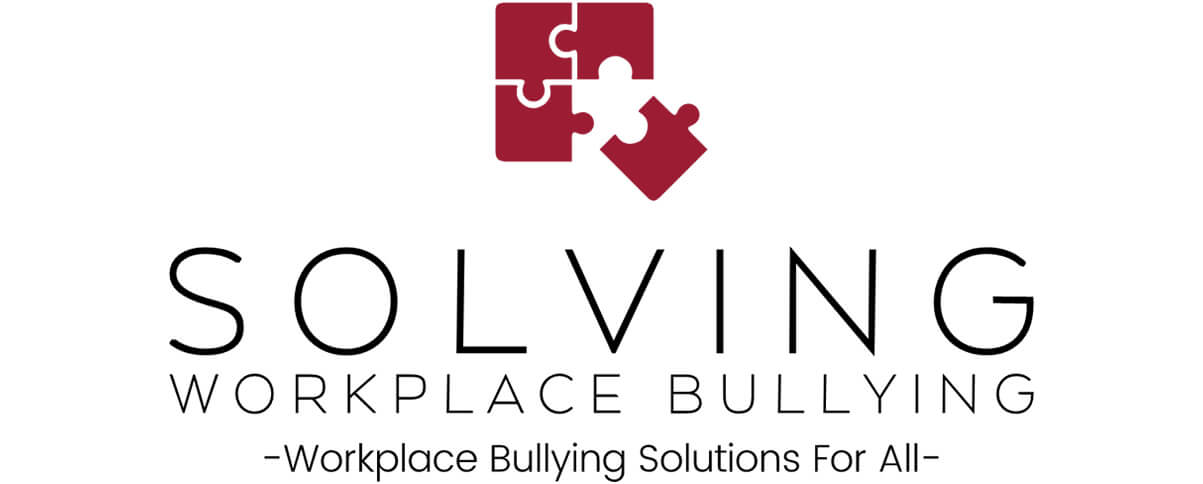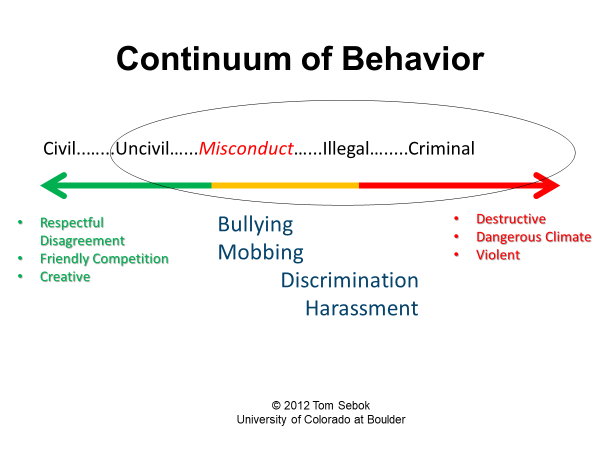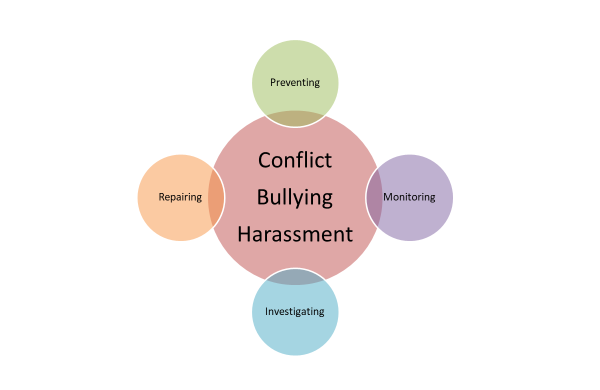Solving Workplace Bullying

Solving Workplace Bullying
40% of Canadians Bullied At Work, Expert Says. (2011, December 6). CBC News Windsor (Retrieved from CBC.ca).
Resolving workplace Bullying is a comprehensive approach to this serious issue that injures employees and their families, damages teams and organization through loss of reputations, production, absenteeism, complaints, grievances, arbitrations and investigations. Deborah Hudson from Filion Wakely Thorup Angeletti LLP details the legal implications for Canadian business. (Retrieved from https://irc.queensu.ca/sites/default/files/articles/workplace-bullying-and-harassment-costly-conduct-by-deborah-hudson.pdf).
Mattice (2009) suggests that the costs of bullying in the US are:
- Bully’s direct manager counseling bully: 80 hours, $8,000
- Victim’s direct manager counselling victim: 150 hours, $15,000
- Witnesses counselling victim: 100 hours, $6,000
- HR talking with managers, bully and target: 10 hours, $1,500
- HR talking with Executives about the problem: 5 hours, $1,500
- HR recruiting and training replacement of victim employee; $40,000
- Team and department members training new employee: 160 hours, $10,000
- Actual costs (advertising, temp agency): $1,000
- Estimated total cost of bully: $83,000
(Retrieved from http://noworkplacebullies.blogspot.com/2009/07/cost-of-workplace-bullying.html )
Behaviour in the workplace can take a variety of forms from civil and respectful to violence.

Respect can be defined as consideration for yourself and others. This includes respect for a person’s privacy, their physical space and belongings, respect for different viewpoints, philosophies, physical ability, beliefs and personality. Respectful behaviour is characterized by treating others with dignity and professionalism and is demonstrated through:
- Courtesy, politeness, and kindness
- Encouragement of differences of opinions and ideas
- Avoiding insults, name calling and putting people down
- Avoiding demeaning or belittling
- Promoting a workplace in which all individuals are treated fairly
- Avoiding clearly discriminatory behaviour
- Treating people with the same respect regardless of individual differences such as race, religion, gender or other characteristics
In a respectful workplace, each individual has the right to work in a professional atmosphere which promotes equal opportunity and prohibits discriminatory practices. In a respectful workplace, communication is clear and direct, employees feel supported by their supervisors and managers, supported by the company, and get along with peers.
Management System Approach
Pat has developed a Management System Approach to reduce the incidence of incivility, workplace bullying and protected grounds harassment. The four factors that Pat believes are important include prevention activities, monitoring processes, investigation skills and resources and repairing interventions and services.

Prevention Services
A solid policy is the foundation of a management system. In addition to meeting the legal requirements of legislation under human rights acts and occupational health and safety acts, a policy serves to provide a statement of organizational commitment to a healthy workplace and makes a strong statement about expectations around relationships amongst workers and its culture. A policy should, therefore, be an employer’s statement of intent and a summary of processes with regards to bullying and harassment. Best practice policies provide greater detail rather than less. Incident reporting forms should be developed and available to Human Resources professionals, managers, and employees.
Pat will review existing policy or help create a best practices policy.
Employers are generally required to provide training to employees and managers on both psychological safety and human rights. Pat provides training to employees and managers on Respect in the Workplace which includes a review of all relevant legal requirements. Her training can be provided by live webinar or in person services.
Training covers:
- Laws and policies that employees and employers are accountable to
- Rights and responsibilities of all employees, managers and their company
- Emergency procedures for serious incidents and what is considered serious
- How to confront someone about behavior
- How to intervene as a witness
- How to receive support and advice
- How to document and report incidents
- How an investigation will be conducted
- Outcomes of investigations
- Supports available
Monitoring Services
Monitoring of the Respectful Workplace program should be carried out on a long-term basis annually through staff attitude surveys, publicising the number of complaints dealt with, and review of the policy every three years or when there has been a serious incident.
Pat can assist organizations to develop surveys, run focus groups, and analyze reports of harassment and workplace bullying.
Responding and Investigating
Pat can provide coaching and consultation on the management of incidents of workplace harassment and bullying. She also provides support to those managing an investigative process and those implementing recommendations from an investigation. Many supervisors/managers find they need advice, support, and insight to the complexities of managing reports and outcomes of complaints and when received manage the people and processes involved more effectively.
Repairing
Injury and damage from harassment and bullying may occur at all levels of the organization. At the individual level, the injury can be severe. The treatment of workplace bullying injury/trauma requires special processes and qualified treatment personnel. Pat has developed treatment protocols with international colleagues and provides specialized treatment to those who have been targeted.
Teams may require trust building post incidents. Pat can assist organizations to develop and deliver appropriate interventions to re-build teams, people, and supervisors.
